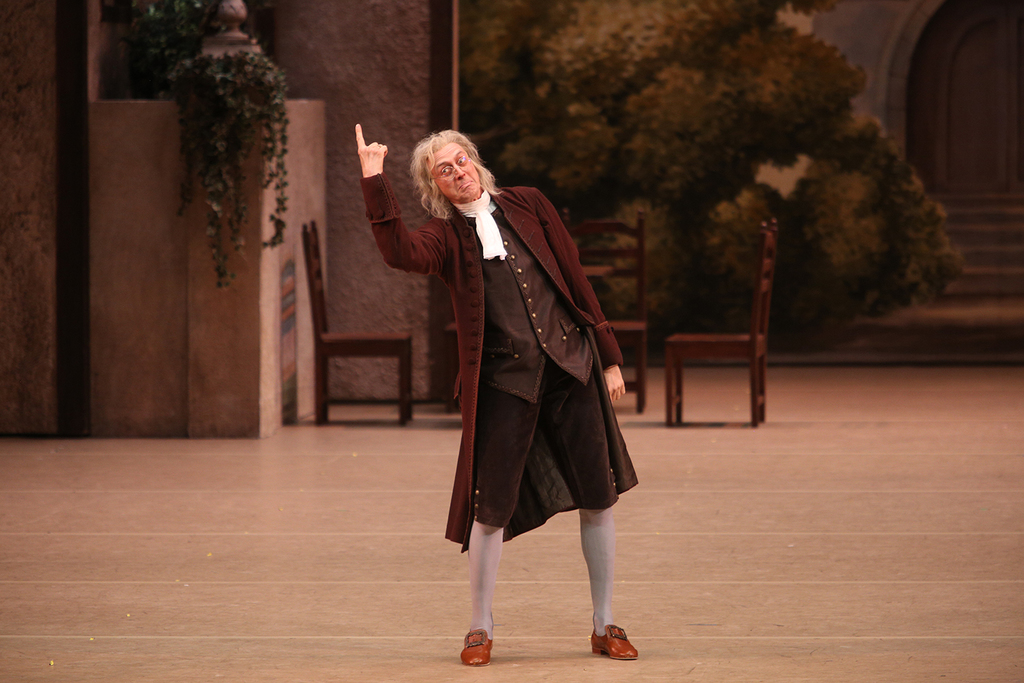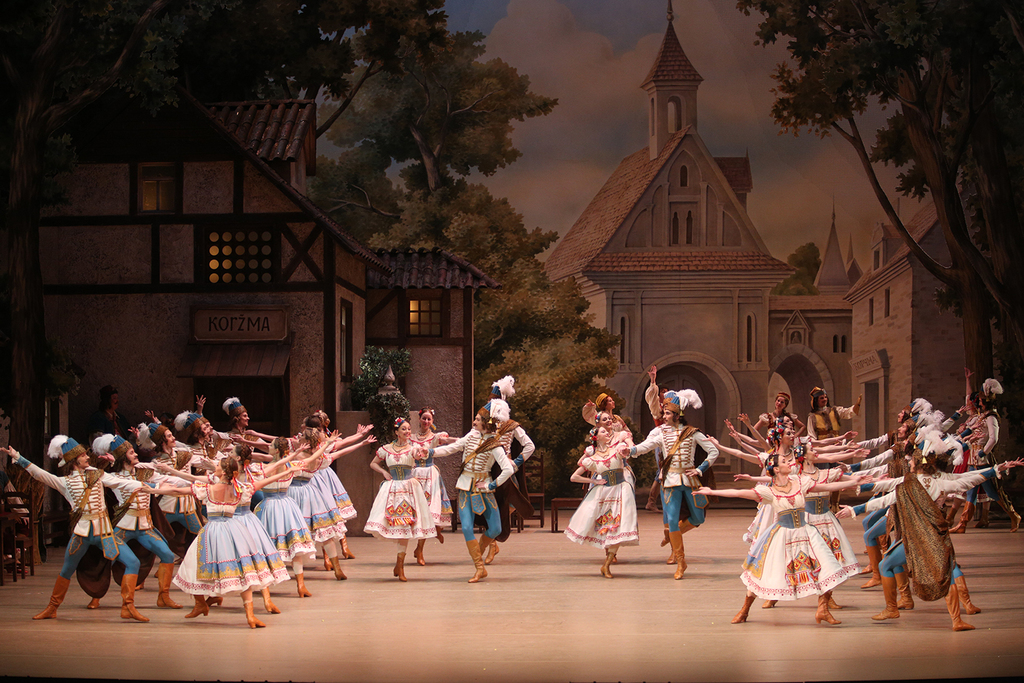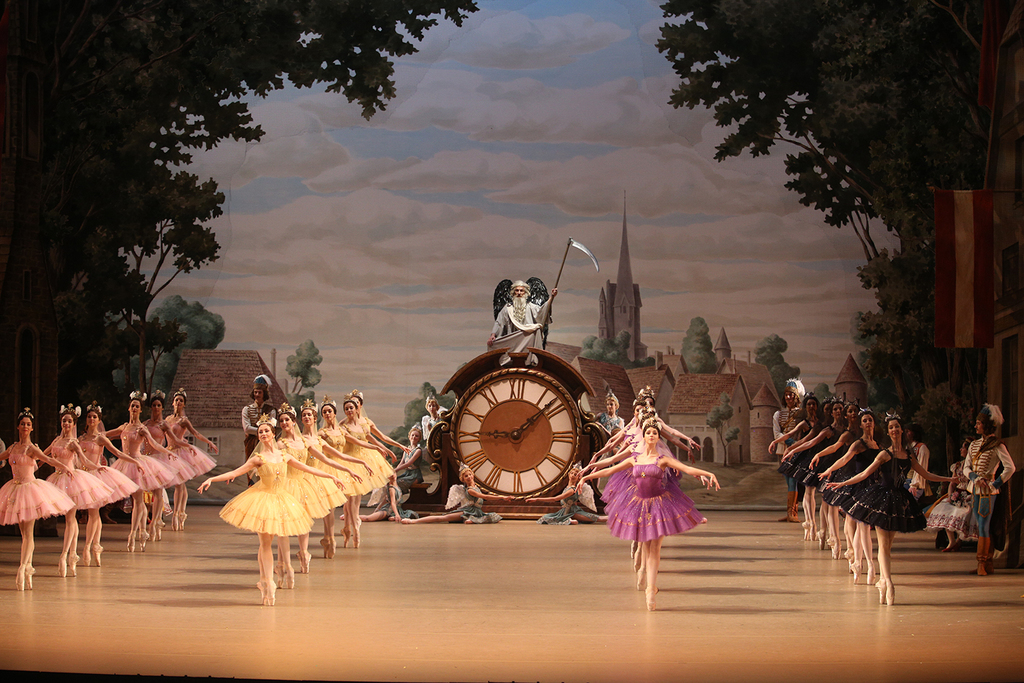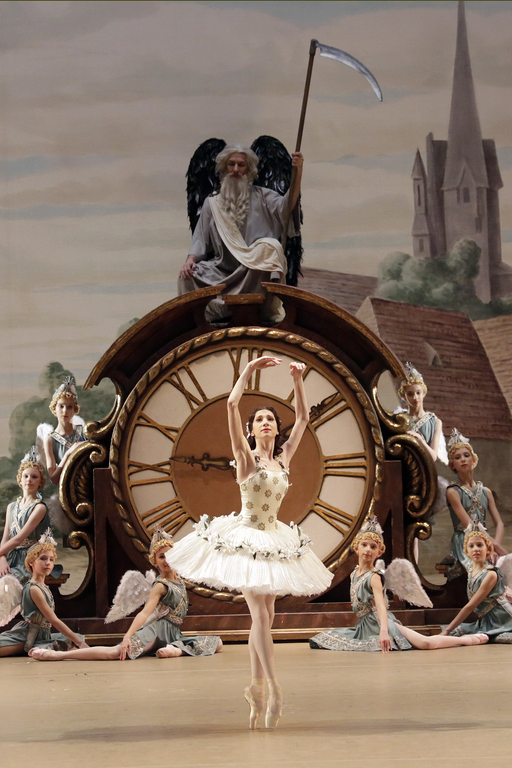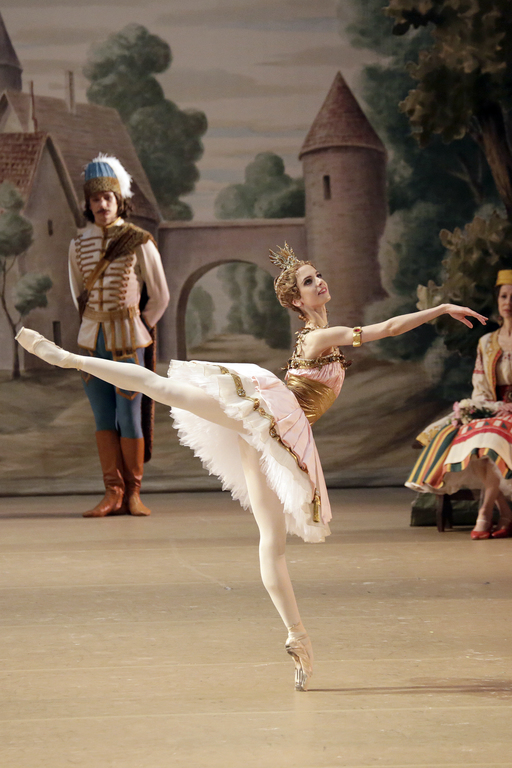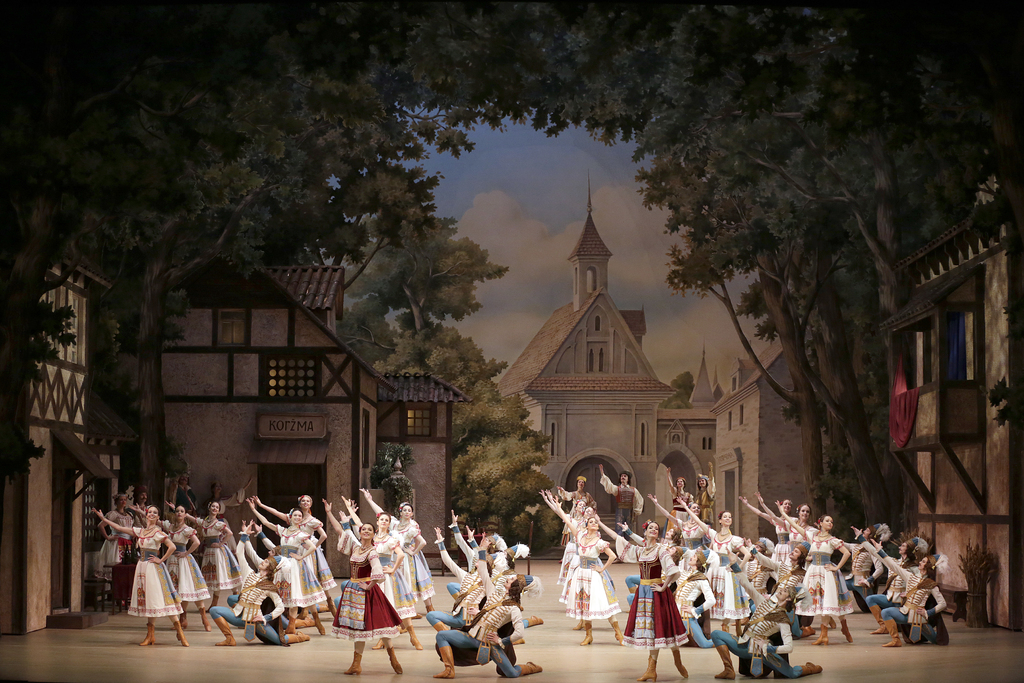
Léo Delibes
Coppelia
Коппелия
Coppelia is a rare comedy among the masterpieces of the classical legacy. The intricate choreography and the delightful score of Léo Delibes bring Hoffmann's story of love, mischief, and mechanical dolls to life. The enchanting ballet was revived by Sergei Vikharev, bringing the charming storybook world to life. This light-hearted and joyful ballet charms adults and children alike, with the beauty and elegance of Margarita Shrayner as Swanilda, Artem Ovcharenko as Frantz, and Alexei Loparevich as Coppelius.
Actors
Сванильда
Франц
Коппелиус
Заря
Молитва
Работа
Безрассудство
Crew
after the stories by Ernst Theodore Amadeus Hoffmann
Choreography: Marius Petipa and Enrico Cecchetti
Revival and new choreographic version: Sergei Vikharev
Designer: Boris Kaminsky
Costume Designer: Tatiana Noginova
Music Director: Igor Dronov
Lighting Designer: Damir Ismagilov
Sets reproduced by Yevgeny Yakimenko and Anton Danilov (Acts I and III), Yelena Kinkulskaya (Act II)
Archive Researches and Coordination: Pavel Gershenzon
Choreography has been restored using notations from the Harvard Theatre Collection.
Set and costume sketches have been made available by the St. Petersburg State Museum of Theatre and Music Arts and the St. Petersburg State Theatre Library.
The score has been made available by the publishing house EDWIN F. KALMUS.
Coppelia was premiered in 1870 at the Paris Opera (The National Academy of Music and Dance). It was choreographed by Arthur Saint-Leon, the choreographer who had relinquished his post as head of the Petersburg Ballet to Marius Petipa. Saint-Leon was also a virtuoso dancer, expert on dance folklore, composer and violinist. It was his interest in folk dance that was responsible for the appearance in the music score of such a rich ’selection’ of dance melodies based on folklore. Coppelia is considered to be one of the first ballets to contain Slav motifs.
In the 14 years between its Paris premiere and Petipa’s own production of the ballet at the Petersburg Bolshoi Theatre, Coppelia was presented in Brussels, at Moscow’s Bolshoi Theatre and in London. Before the end of the 19th century, it was also staged in New York, Milan, Copenhagen, Munich and once more in Petersburg, this time at the Mariynsky Theatre. There were more productions in the 20th century, including ultra modern interpretations when sometimes even its comic element was dropped. The second (1894) Petersburg version of Coppelia (choreographed by Marius Petipa and staged by the Italian teacher and ballet master, Enrico Cecchetti, who was working at the time in Petersburg), was revived at the Bolshoi Theatre by ballet scholar Pavel Gershenzon and Sergei Vikharev, famous Mariynsky Theatre principal dancer and ballet master-restorer.
In 2001, the premire of their reconstructed Coppelia was held at Novosibirsk Theatre of Opera and Ballet. The production made such an impact on audiences that the following year it won a Golden Mask, the National theatre prize.
A public Square in a small town, on the borders of Galicia, with wooden houses painted with bright colors. One house stands outin contrast to the others, with grating before the windows and the door securely fastened. This is the residence of Coppelius.
Swanilda is approaching the house of Coppelius, raises her eyes to a large window, behind which Coppelia, the daughter of old Coppelius, is seen, sitting with a book in her hands apparently absorbed in her reading. Every morning she is seen at the same window and in the same attitude, and then disappears. She never goes out from this mysterious residence. She appears to be pretty, and many young men in the town have passed long hours beneath her window, beseeching for one look.
Swanilda suspects that her fiance, Frantz, is not indifferent to the beauty of Coppelia. She tries to attract her attention, but Coppelia has her eyes always fixed on her book, of which she does not even turn the leaves.
Swanilda cannot contain her feelings of anger. She starts to knock at the door, but she perceives Frantz approaching, and remains in hiding to see what he is going to do.
Frantz, who at first was going toward Swanilda house, suddenly stops. Coppelia is at the window. He bows to her. At the same time she turns her head and appears to return Frantz’s salute. Frantz has scarcely time to throw a kiss to Coppelia before old Coppelius has opened his window, and seems to be amused at what has been going on.
Swanilda is furious against Coppelius and against Frantz. However, she remains quiet and pretends to have seen nothing. She runs after a butterfly. Frantz runs with her, and catching it, pins it in the collar of his coat. Swanilda reproaches him for his cruelty: “What has this poor insect done to you?” After many reproaches, the young maid brings herself to tell him, that she knows all. He has deceived her. He loves Coppelia. Frantz tries in vain to defend himself.
The Burgomaster announces that on the next day a grand fete will take place — the Lord of the manor has given a bell to the Town. They crowd round the Burgomaster. The noise is being made in Coppelius’ house. Odd looking lights are shining at the windows. Some of the girls shrink with fear from this mysterious abode. But it is nothing but the clash of the hammer on the anvil, and the light is the reflection from the forge. Coppelius is an old fool who is always working. At what? No one knows and who cares? He must be left alone and not be stopped from amusing himself. The Burgomaster approaches Swanilda. He tells her that tomorrow the lord of the manor will give a dowry and marriage to several couples. She is betrothed to Frantz; shall they not be united tomorrow? Ah! but there is time yet, and the young girl looking spitefully at Frantz, tells the Burgomaster that she will tell him a story. It is the story of a straw which reveals all secrets.
Swanilda takes the straw from a bundle, and placing it to her ear, pretends to listen; then she tells Frantz to listen also. Does it not tell him that he does not love Swanilda? Frantz answers that he hears nothing. Swanilda tries it with one of Frantz’s friends, who pretends to hear very distinctly what the straw says. Frantz tries to protest, but Swanilda breaking the straw before his eyes, tells him that everything is broken between them. Frantz goes away, while Swanilda dances in the midst of her companions. Glasses are placed on the tables, and they drink the health of the lord ofthe manor and the Burgomaster.
Coppelius leaves his house and securely fastens the door. He has not gone many steps, before he is surrounded by a crowd of young fellows; some of whom want to take him away with them, while the others want to make him dance. The old man goes off swearing.
Swanilda is bidding adieu to her friends, when one of them sees a key, which Coppelius must have dropped.
The girls suggest to Swanilda to visit the mysterious house. At first Swanilda hesitates, but she wants to meet this rival. “Well, then, let us enter, ” she says. The girls enter the house of Coppelius.
Frantz is seen coming up, carrying a ladder. He has determined to see what chance he has with Coppelia. The opportunity is most favorable and Coppelius is far off! But it is not so, for just as Frantz is steadying the ladder against the balcony, he sees Coppelius returning and looking for the lost key. He sees Frantz just about to climb the ladder. Frantz runs away.
Act II
A large room is full of all kinds of instruments and tools. There are several automata on pedestals. There are figures of an old man, dressed in Persian costume, a Negro in threatening attitude, a little Moorish cymbal-player, a Chinaman with a tympanon before him.
The girls cautiously enter Coppelius’ house. Who are those people standing still in the dark shadows? They are face to face with the strange figures which a moment before had so frightened them. Swanilda draws aside the heavy curtains. There she sees Coppelia seated with her book in her hand. Swanilda salutes the strange girl who remains motionless. She speaks to her, but gets no answer. She touches the young girl’s arm and then starts back through fear. Can it be a living creature? She puts her hand to the heart, but it does not beat. This young lady is an automaton, and thehandy-work of Coppelius! Swanilda doesn’t worry herself any more about her rival, but looks forward to the fun of telling Frantz all about her discovery. The girls run laughing, around the studio.They have nothing to fear now.
One of them in passing by the Tympanon player, touches it by accident. It begins playing a tune. The girls are at first bewildered, but soon begin dancing. They then find the spring, which sets the little Moorish figure in motion.
Suddenly Coppelius returns in a furious rage. He draws together the curtains which conceal Coppelia; stops the automata and runs after the girls. They slip through his hands and disappear down the back stairs. Swanilda is hiding behind the curtains. She is caught! but no; crouching in a corner she remains unseen when Coppelius looks behind the curtain. He examines Coppelia and finds that no harm has been done. He breathes more freely.
But what is that noise? He sees the top of a ladder in the window and then Frantz appears. Coppelius does not show himself. Frantz is going toward the spot where he has seen Coppelia, when two stout hands seize him. Frantz nearly dead with fright, implores Coppelius to forgive him. He tries to escape, but the old man holds him tightly. “What are you up to here?” he asks. Frantz confesses that he is in love. “I am not so bad as people say. Sit down and let us take a drink together and have a chat, ” answers Coppelius. He gets an old flagon of wine and two goblets. He takes a sip with Frantz, and then, when Frantz is not looking, he throws away the wine.
Frantz finds that the wine has a peculiar taste. He tosses it down, however, and Coppelius makes him drink more and more. Frantz tries to get near the window where he has seen Coppelia. But his legs give way, he falls heavily on the bench and is asleep.
She sees the vial and places it to her lips. Coppelius is just in time to snatch the flagon from her hands. She perceives the magic book and asks Coppelius what it means. “There are impenetrable secrets, ” he answers, and closes the book. She examines the automata. “I have made them all, ” Coppelius says. She stops in front of Frantz. “And that one?” she asks. “It is like the rest, ” he answers. She sees a dagger and pricks her own finger with the point of it and then amuses herself by thrusting it at the little Moor. Coppelius roars with laughter... but she approaches Frantz... The oldman stops her and she turns against him and chases him around the studio. At last he disarms her. He throws a cloak over her shoulders, and it seems to awaken in her a world of new ideas. She dances a Spanish dance. Then she finds a Scotch scarf-pin and taking it in her hands, she dances a jig. She jumps and runs around, throwing everything within her reach to the ground and breaking it! She is decidedly too lively! What shall Coppelius do!
A lawn in front of the baronial castle. At the back, the bell, the gift of the lord of the manor, is hung from poles, decorated with garlands and banners. A car covered with allegorical designs and on which are grouped the various actors for the fete, has just stopped in front of the bell.
The priests have pronounced a benediction over the bell. The betrothed couples who are to be given a dowry, and are to be united on this festal day go and bow before the baron. Frantz andSwanilda complete their mutual reconciliation. Frantz has disabused himself of his temporary infatuation and thinks no more of Coppelia. He knows what a joke has been played upon him. Swanilda forgives him and giving him her hand, advances with him before the lord of the manor.
All at once there is a stir among the crowd. Coppelius comes to implore and even to demand justice; they have ridiculed him and have broken everything in his house, his masterpieces made with the greatest labor and patience, have been smashed. Who is going to pay him? Swanilda, who has just received her dowry, quickly offers it to Coppelius. But the lord of the manor stops Swanilda. She may keep her dowry. He throws a purse to him and whilst Coppelius departs with his money, he gives the signal for the festivities to begin.
The Bell-ringer alights first from the car. He summons the Morning Hours. They appear, quickly followed by Aurora. The bell rings! It is the Hour of Prayer. Aurora vanishes, chased by the Hours ofDay. These are the working hours, and the young girls and reapers begin their work. The bell rings again! It announces a wedding.
Language
English, french, russian
Runtime
2 hours 8 minutes with two intermissions
Act 1
46 min
Intermission
13 min
Act 2
29 min
Intermission
5 min
Act 3
35 min
2018
6+
The Bolshoi Ballet. Season 2020-2021
Весь сезонCan be interesting for you

The Last Fairy Tale
23 December, Tuesday
19:00 Mirage Cinema at Marmelade Mall
Language: Russian, no subtitles

Rudolf Nureyev: The Nutcracker
28 December, Sunday
15:00 Mirage Cinema at Marmelade Mall
Language: none, russian subtitles







